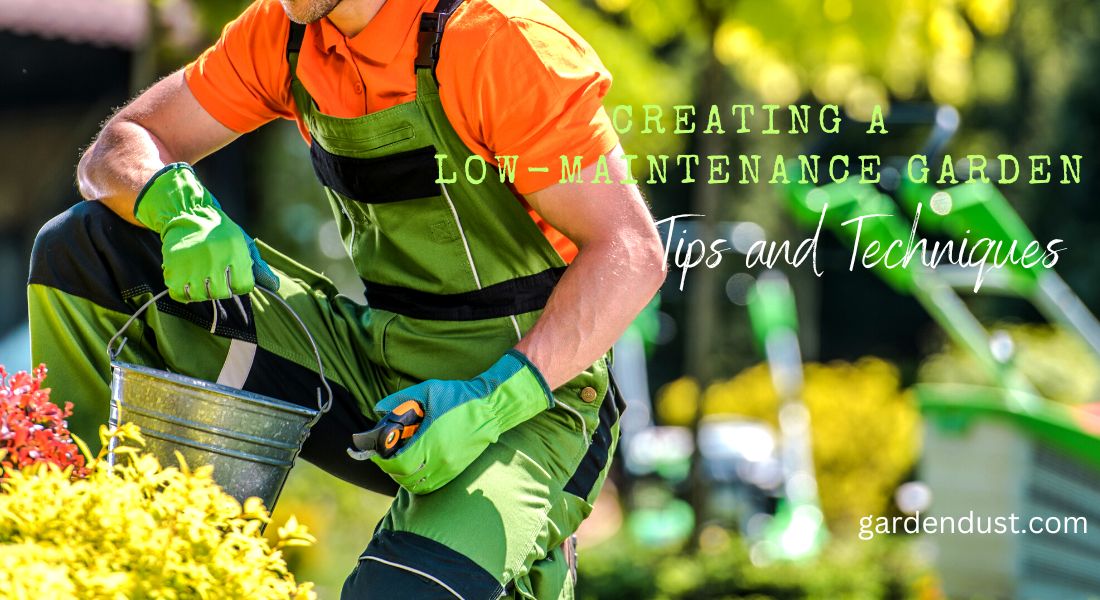Gardening can be a rewarding and fulfilling hobby, but it can also be time-consuming and demanding. For those who lead busy lives or simply don’t want to spend too much time tending to their gardens, creating a low-maintenance garden can be a great solution. By choosing the right plants, designing the garden layout appropriately, and implementing some techniques, you can have a beautiful garden that requires minimal upkeep. In this article, we will discuss some tips and techniques for creating a low-maintenance garden.
Choose the right plants
Selecting the right plants is crucial for creating a low-maintenance garden. Look for plants that are easy to care for, have a long lifespan, and are resistant to pests and diseases. Native plants are also a good choice as they are well adapted to the local climate and require less care. Some examples of low-maintenance plants include:
- Perennials: These are plants that come back year after year, and they require less maintenance than annuals. Examples include lavender, hostas, daylilies, and ornamental grasses.
- Shrubs: Shrubs are generally low-maintenance plants that require pruning once a year. Examples include boxwood, yew, and juniper.
- Trees: Trees can provide shade, privacy, and beauty to your garden. Choose trees that are adapted to your climate and soil conditions. Some low-maintenance trees include oak, maple, and crabapple.
- Groundcovers: Groundcovers are plants that spread to cover the ground, reducing the need for mulch and weeding. Examples include creeping thyme, creeping phlox, and sedum.
Design the garden appropriately
The layout of your garden can also affect its maintenance requirements. Consider the following tips when designing your low-maintenance garden:
Group plants with similar watering needs together to make watering more efficient.
Use raised beds or containers to reduce the need for weeding and to control soil quality.
Use mulch to suppress weeds and retain moisture in the soil. Choose organic mulch such as wood chips, straw, or leaves, which will break down over time and add nutrients to the soil.
Use a drip irrigation system to water your plants efficiently. This will reduce water waste and save you time.
Create pathways that are easy to maintain. Consider using permeable materials such as gravel, pavers, or stepping stones.
Implement some techniques
In addition to choosing the right plants and designing your garden appropriately, there are some techniques you can use to further reduce maintenance requirements:
Use compost: Composting is an excellent way to add nutrients to your soil, reduce waste, and promote healthy plant growth. Use compost as a soil amendment, mulch, or fertilizer.
Practice companion planting: Companion planting involves planting different species of plants together that complement each other. For example, planting marigolds alongside vegetables can help repel pests, while planting clover alongside grass can add nitrogen to the soil.
Use natural pest control methods: Avoid using chemical pesticides and herbicides, which can harm beneficial insects and pollinators. Instead, use natural methods such as handpicking pests, using insecticidal soap, or attracting beneficial insects to your garden.
Choose low-maintenance grass: If you have a lawn, choose a low-maintenance grass variety that requires less watering, fertilizing, and mowing. Some examples include fescue and buffalo grass.
Maintain your garden regularly
Even low-maintenance gardens require some maintenance. Regularly inspect your plants for pests and diseases, prune shrubs and trees as needed, and remove weeds before they become established. Water your plants as needed, but be careful not to overwater them, as this can lead to root rot and other problems.
In conclusion, creating a low -maintenance garden is achievable by selecting the right plants, designing the garden appropriately, and implementing some techniques. With a little bit of planning and effort, you can create a beautiful garden that requires minimal upkeep, allowing you to spend more time enjoying it rather than tending to it. By choosing low-maintenance plants, designing the garden to reduce maintenance requirements, using compost and natural pest control methods, and maintaining the garden regularly, you can achieve a low-maintenance garden that is both beautiful and sustainable.
Choosing low-maintenance plants is key to reducing maintenance requirements in your garden. By selecting plants that are adapted to your local climate, resistant to pests and diseases, and have a long lifespan, you can reduce the need for watering, fertilizing, and pruning. Native plants are a great choice as they are well adapted to the local climate and require less care. Perennials, shrubs, trees, and groundcovers are all good options for a low-maintenance garden.
Designing your garden appropriately can also reduce maintenance requirements. Grouping plants with similar watering needs together, using raised beds or containers, and using mulch to suppress weeds and retain moisture in the soil are all effective ways to reduce maintenance requirements. Using a drip irrigation system and creating pathways that are easy to maintain are also helpful.
Implementing some techniques can further reduce maintenance requirements in your garden. Composting, practicing companion planting, using natural pest control methods, and choosing low-maintenance grass varieties are all effective techniques to reduce maintenance requirements. Regularly inspecting your plants for pests and diseases, pruning shrubs and trees as needed, and removing weeds before they become established are also important maintenance tasks.
In summary, creating a low-maintenance garden is achievable by following these tips and techniques. By selecting the right plants, designing the garden appropriately, implementing some techniques, and maintaining the garden regularly, you can create a beautiful garden that requires minimal upkeep. With a little bit of effort and planning, you can enjoy your garden without spending too much time tending to it.







